RETROSTYLOID PARAPHARYNGEAL SPACE MASSES
KEY POINTS
- All masses presenting submucosally around the pharynx or presenting in the deep face should be imaged before they are biopsied.
- Imaging with magnetic resonance and/or computed tomography usually provides the most pivotal information in medical decision making with regard to parapharyngeal masses.
- Such imaging will almost always narrow differential considerations to one very likely possibility in retrostyloid parapharyngeal space masses.
- Imaging-guided biopsy is a very useful adjunct in properly selected cases.
INTRODUCTION
The retrostyloid parapharyngeal space (RSPS) is discussed in this chapter as the site of origin of mass lesions of the head and neck. The RSPS is a common secondarily involved site in several inflammatory conditions such as necrotizing otitis externa and mucosal-origin neoplastic conditions such as nasopharyngeal squamous cell carcinoma; these are discussed in other chapters. The spectrum of disease seen in the RSPS yet not necessarily originating there but arriving by transspatial spread is outlined in Table 144.1.
Clinical Presentation
Smaller masses in the RSPS are typically discovered as incidental findings on studies done for other purposes. The majority of larger lesions are discovered because the patient or a health care provider notices an upper neck mass or submucosal bulge along the oropharyngeal wall usually at about the level of the palatine tonsil. Fewer are discovered because of symptoms related to the mass, although cancers can cause pain either due to local effects or skull base invasion and if they invade adjacent spaces. They may also present as a cranial neuropathy; the most common presentation in this category is dysphonia or hoarseness due to vocal cord paralysis as a result of a vagal neuropathy. Other less common neuropathies are those of the hypoglossal nerve and a sympathetic neuropathy manifesting as Horner syndrome.
APPLIED ANATOMY
In the suprahyoid neck, the spaces adjacent to the visceral compartment are more numerous and structurally somewhat more complex than they are in the infrahyoid neck. They include the parapharyngeal space (pre- and retrostyloid divisions), retropharyngeal space, prevertebral space, masticator and buccal spaces (Figs. 142.3–142.7, 144.1, and 144.2), parotid gland within its capsule, and submandibular space. The parotid and submandibular glands are discussed in Chapter 179.
The primary skills necessary to interpret computed tomography (CT) and magnetic resonance (MR) studies of the deep spaces of the face and supra- and infrahyoid neck are common to these areas and include the following:
- Thorough knowledge of the anatomy.
- Realization that the differential diagnosis:
- Is primarily anatomically driven and largely based on analysis of point of origin and displacement of normal anatomic structures (Figs. 144.1 and 144.2).
- Requires a rudimentary knowledge of developmental disorders.
- Is aided by a familiarity of the morphology of lesions as seen on MR and CT of the more common lesions in each space.
- Must take into account that disease may spread transcompartmentally because the process is aggressive and/or extends along existing anatomic structures (e.g., nerve, vessel, muscle bundles, and lymphatics).
- Is primarily anatomically driven and largely based on analysis of point of origin and displacement of normal anatomic structures (Figs. 144.1 and 144.2).
Spatial Boundaries
The RSPS is separated from the prestyloid parapharyngeal space (PSPS) by the musculofascial sheath associated with the stylopharyngeus, styloglossus, and stylohyoid muscles. It contains fat, the carotid artery, the jugular vein, cranial nerves IX through XII, and the cervical sympathetic trunk (Figs. 142.3–142.7, 144.1, and 144.2). The space comes into contact directly with the skull base posterior to the styloid and the foramen ovale. The RSPS is continuous with the carotid sheath and lateral compartment of the neck bound by the anterior and posterior triangles and the paravertebral and sternocleidomastoid muscles (Figs. 144.1 and 144.2). The relationships explain why masses in this space are frequently approached surgically through the neck, dissecting cephalad along the carotid sheath.
Structures of Interest
The analysis of a mass in the RSPS depends on a thorough understanding of the PSPS relationship to the following structures:
Superiorly: Posterior skull base in the area of the carotid foramen and jugular fossa
Inferiorly: Carotid sheath
Anteriorly: Styloid musculature and PSPS
Posteriorly: Laterally, the upper cervical spine, paravertebral muscles, and related fascia; more medially, the upper cervical spine and prevertebral fascia
Medially: Pharyngeal constrictor muscles, retropharyngeal space, and the lateral retropharyngeal lymph nodes
Laterally: Styloid process and the stylomandibular tunnel, mandible, and parotid gland
TABLE 144.1 SUMMARY OF ROUTES AND MECHANISMS OF TRANSSPATIAL SPREAD OF PARAPHARYNGEAL SPACE DISORDERS
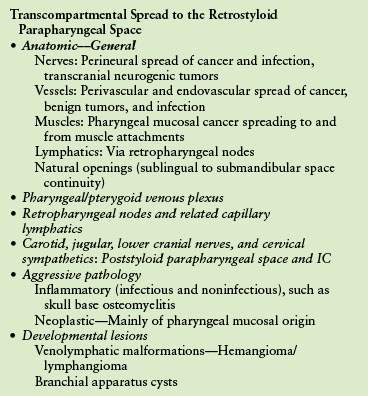
IMAGING APPROACH
Computed Tomography and Magnetic Resonance Imaging
The suprahyoid neck is studied in essentially the same manner as the nasopharynx is evaluated with magnetic resonance imaging (MRI) and CT. The specifics and relative value of using these studies in this anatomic region are reviewed in Chapter 184. Problem-driven protocols for CT and MRI are presented in Appendixes A and B. In general, MRI is more definitive than CT in the evaluation of deep space masses in the suprahyoid neck, and the images are usually of excellent quality especially above the hard palate.
Other
Ultrasound has no significant role to play in the evaluation of these masses. The approach with radionuclide studies depends on the specific aim of the examination. Most current usage is limited to known or suspected cancer evaluation with fluorine-18 2-fluoro-2-deoxy-D-glucose positron emission tomography (FDG-PET) and bone/gallium scans for inflammatory pathology; both are discussed in other chapters. The use of FDG-PET should be very limited in the RSPS since over 90% of these masses are benign. Catheter angiography is used only occasionally since the recent developments in computed tomographic angiography (CTA).
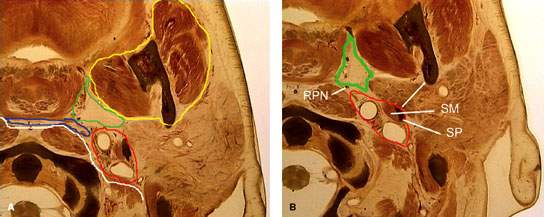
FIGURE 144.1. Whole organ sections showing anatomic relationships of the spaces in the suprahyoid neck in relationship to the prestyloid parapharyngeal space (PSPS) and retrostyloid parapharyngeal space (RSPS). A: Section at the mid palatine tonsillar level. The retropharyngeal space is outlined in blue and the prevertebral space in white. The parapharyngeal space is divided into the prestyloid component outlined in green and the retrostyloid component outlined in red. The masticator space is outlined in yellow. B: A section featuring the anatomy of the parapharyngeal space and contained adjacent structures. This is a magnified image of that seen in (A). The PSPS is outlined in green and the retrostyloid space in red. Note the position of the retropharyngeal lymph node (RPN) relative to the two spaces. Also note the important landmarks separating these two spaces—the styloid process (SP) and the styloid musculature (SM). The white line drawn between the styloid processes and the mandibular ramus defines the stylomandibular tunnel. The parotid gland deeper portion typically protrudes through this gap. C: A more inferior section showing the overall relationship between the RSPS and other deep spaces with color coding of spaces as seen and indicated previously in this figure legend. D: Anatomic diagram showing important anatomic landmarks within the RSPS. Note that the lateral retropharyngeal node (RPN) lies at the border of the RSPS and the retropharyngeal space and medial to the carotid sheath. Note that the sympathetic plexus also lies medial to the other structures within and surrounding the carotid sheath at this level. This includes cranial nerves IX through XII.
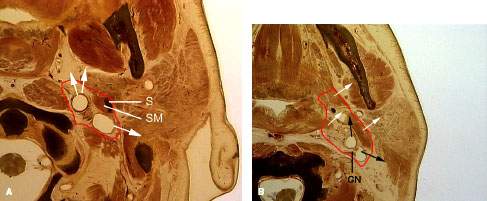
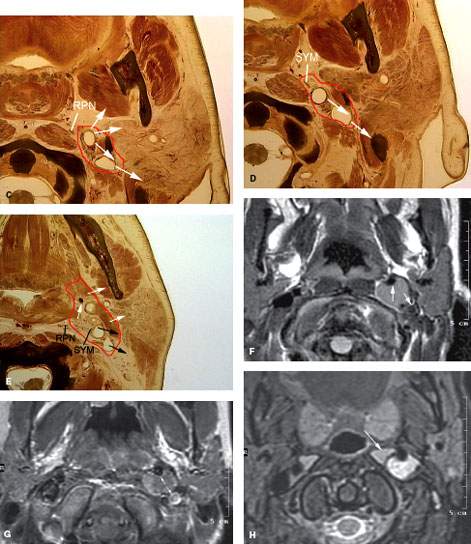
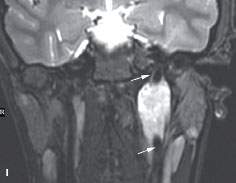
FIGURE 144.2. Anatomic diagrams similar to that seen in Figure 144.1 to demonstrate the anatomic relationships that explain the vectors of travel and displacement of surrounding structures when masses primarily involve the prestyloid parapharyngeal space. A: The retrostyloid parapharyngeal space (RSPS) is outlined in red. The white arrow indicates that a mass arising with this space from cranial nerves IX through XII will tend to separate the carotid artery and jugular vein. The black arrows indicate that the styloid musculature (SM) and process (S) will be displaced laterally and anteriorly by an RSPS mass. B: The RSPS is outlined in red on a section inferior to that in (A). The black arrows indicate that masses arising with this space from cranial nerves IX through XII (CN) will tend to separate the carotid artery and jugular vein. The white arrows indicate that the styloid musculature will be displaced laterally and anteriorly by an RSPS mass. C: The RSPS is outlined in red on a section equivalent to that in (A). The white arrows indicate that a mass arising from the lateral retropharyngeal lymph node (RPN) will tend to displace the carotid artery, jugular vein, and related cranial nerves laterally. D: The RSPS is outlined in red on a section equivalent to that in (A). The white arrows indicate that a mass arising from the cervical sympathetic trunk or ganglion (SYM) will tend to displace the carotid artery, jugular vein, and related cranial nerves posteriorly and laterally. E: The RSPS is outlined in red on a section inferior to that in (A), (C), and (D) and the same as that in (E). The white arrows indicate how a mass arising from the cervical sympathetic trunk or ganglion (SYM) or the lateral retropharyngeal lymph node (RPN) will tend to displace the carotid artery, jugular vein, and related cranial nerves. F–H: Contrast-enhanced T1-weighted images in (F) and (G) and a T2-weighted image in (H) showing an incidentally discovered nerve sheath tumor of one of the lower cranial nerves related to the carotid sheath on the left. In (F), the carotid artery and jugular vein are being separated by the mass that enhances homogeneously and slightly (arrows). In (G), the mass in seen separating those vessels again (arrows) as it expands medial and lateral within the RSPS. In (H), the mass is seen as homogenously bright between the carotid artery and jugular vein. Note the relationship of the lateral retropharyngeal node (arrow) to both the mass and the carotid sheath. This relationship explains the differences in vectors of displacement seen when a mass in this location arises from the retropharyngeal nodes as opposed to the lower cranial nerves. The retropharyngeal node can also be used as a surrogate for the sympathetic plexus or ganglion, and the difference between displacements related to the sympathetics could also be anticipated from these anatomic relationships as demonstrated earlier in this figure in the anatomic sections. In (I), the coronal section shows the schwannoma extending along the carotid artery (arrows) to just below the carotid entry into the skull base.
PATHOPHYSIOLOGY AND PATTERNS OF DISEASE AND DIFFERENTIAL DIAGNOSIS AS SEEN ON MAGNETIC RESONANCE IMAGING AND COMPUTED TOMOGRAPHY
Introduction
The initial evaluation of a mass involving the RSPS must determine whether it is actually secondary involvement related to a primary mucosal disease spreading to the space (Chapters 21–23) or due to a transspatial process arising deep to the mucosa in the spaces of the suprahyoid neck, such as a retropharyngeal nodal metastasis or skull base lesion. Transspatial disease processes deserve some explanation at this point since they may begin in the RSPS and they are, regardless of space of origin, masses that arise in the deep spaces of the suprahyoid neck. The mechanisms and potential routes of transspatial spread are summarized in Table 144.1. For aggressive pathologies such as cancers or skull base osteomyelitis (most commonly, necrotizing otitis externa), transspatial spread is an intuitive concept since such pathology is unlikely to respect most soft tissue boundaries and can grow freely along vessels and nerves. For developmental lesions, a little more specialized but still simple knowledge is required, such as how venolymphatic malformations grow due to disordered vascular budding so that they follow vessels as those vessels normally traverse various compartments or spaces (Figs. 144.1 and 144.2). The tendency of nerve sheath tumors, especially plexiform neurofibroma, to follow nerves across spatial boundaries is another example of a potentially transspatial benign mass.
TABLE 144.2 RETROSTYLOID PARAPHARYNGEAL SPACE MASS ANALYSIS BY EFFECTS ON SURROUNDING ANATOMY
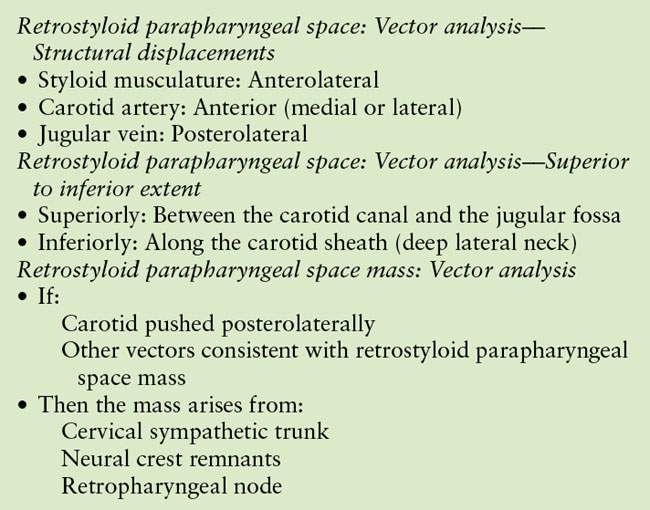
Stay updated, free articles. Join our Telegram channel

Full access? Get Clinical Tree








